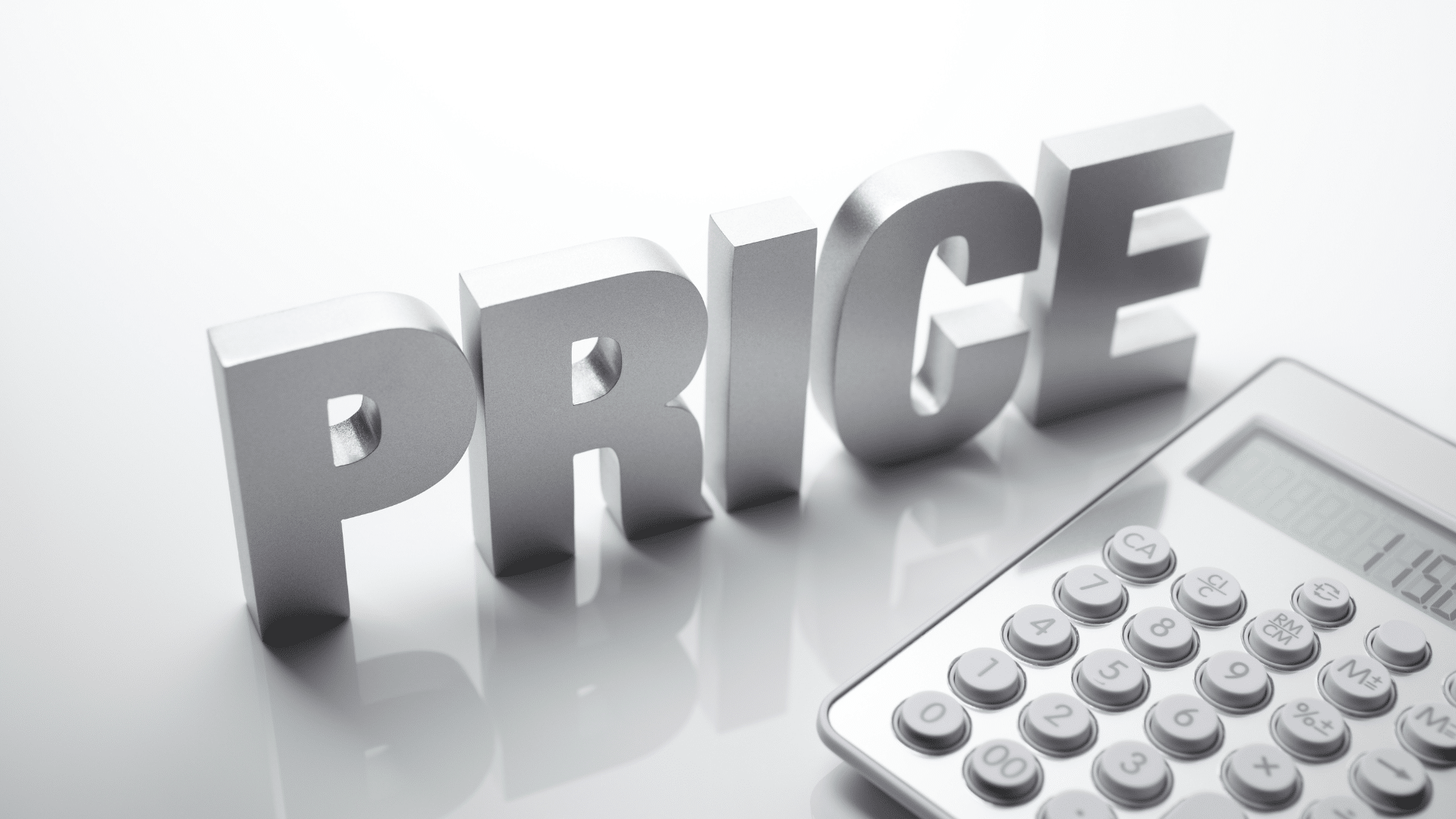
So many SMEs struggle with pricing because they think a one-size-fits-all pricing proposition is good enough in the early stages when it’s not. We understand that setting up a business is full of challenges. It needs a huge amount of willpower, patience, time and effort. If you are a small and medium-sized business owner who wants the best pricing strategy for small businesses, you want to gain a detailed understanding of what your customers value about your products or services, before you set prices. Thus, if you want to learn more about the topic, read on.
>Download Now: Free PDF How to Drive Pricing Strategy to Maximise EBIT Growth
In addition, you will also gain knowledge on how not to undercharge or overcharge your customers. Furthermore, you will discover how to price your new products and of course, you will know the best pricing strategy for SMEs. We also offer strategies based on value that small businesses can adopt to achieve sustainable growth and effective pricing strategies, even when faced with an economic downturn.
A value-based approach to pricing is the basis of a robust pricing proposition that’ll help you generate significantly more revenue at higher margins. While slaughtering the competition in the process.
Table of Contents:
I. The Best Pricing Strategy For Small Businesses to Avoid Under Or Overcharging Your Customers
II. How Small Businesses Can Survive The Threats Of An Economic Downturn
Capability Building Programmes For Pricing & Sales Teams!

The Best Pricing Strategy For Small Businesses to Avoid Under Or Overcharging Your Customers
It is common for SMEs to undercharge a product or service when they think their product or service is of low value to the customer or commonplace in the market. They feel their only option is to compete on price and not test their assumptions on value with their actual customers.
This type of pricing position is not the best pricing strategy for small business owners. They miss out on revenue opportunities and hand over hard-earned margins to their competitors.
Conversely, it is also common for SMEs to overcharge for products or services when a product or service is novel, new or of high value to their customers. This is called a skimming strategy and not a bad approach to take if the product or service is completely new in the market, rather than being a new version of an existing product – a big difference.
Here’s why…
When a product is new, customers perceive it as a risky purchase. They think it may not perform as expected… They think it could be faulty… they think it could create a stir with their friends and network.
A skimming strategy can be the best pricing strategy for small business owners when a product or service is completely new or novel (like software as a service). The riskiness of the new product or service is likely to overwhelm customers’ concerns about price. Customers are also more likely to buy a new or novel service based on its value to them. They’ll be more likely to examine value before price, which is always the best pricing strategy for small business owners.
Also, for the small group of customers who are early adopters and like innovations, the excitement of the product’s new capabilities means they are less sensitive to price (i.e., think the iPhone launched 5 years ago).
Read our article about Subscription Marketing Strategy.
Introduction to Price Optimisation 💰 Podcast Ep. 74!
Tips for working out your pricing proposition as a small or medium-sized business owner
The best pricing strategy for small business owners is a value-based pricing strategy.
Taylor Wells pricing and talent advisory firm highly recommends that small business owners take a phased approach to building their pricing proposition:
- Obviously, understand your costs. However, do not base a markup on fixed and variable costs, just variable costs (i.e., cost of goods sold). Why? Because, if you use both, you will inevitably price yourself out of the market and your competitors will gain market share.
- Look at what competitors are doing. Examine market dynamics like seasonality, price cycles, quote to book or conversion; and price realisation. This is a good way to get a reference point on pricing in the market. But it’s not exhaustive. You then have to understand your customers.
- Then, gain a detailed understanding of customer value drivers – i.e., how they value your products. Turn that understanding into quantified estimates of their willingness to pay for your products or services. This is called customer value driver analysis.
A value-based approach to pricing analysis is the best pricing strategy for small business owners. A value-based pricing proposition will help you make informed price changes without losing hard-earned revenue or volume. As you go through this process, many of you will find that you have been unwittingly overcharging your customers. You may also find that you’ve been selling yourself short. This process will help find new revenue opportunities to regain control of your pricing.
Pricing Recruitment For Pricing Managers!
Implications
Though customers are price-sensitive, they’re more likely to buy a product or service that has value to them. They examine value first before price.
A good way to get a reference point on pricing, SMEs should look at what competitors are doing. They should study market dynamics like seasonality, price cycles, conversion, etc.
SMEs should do a customer value driver analysis. They should have a detailed understanding of how customers value a product or service. Then turn that understanding into quantified estimates of the customer’s willingness to pay for a product or service.
〉〉〉 Get Your FREE Pricing Audit 〉〉〉
Conclusion
Setting up a business is full of challenges. It requires an extensive amount of determination, patience, time and effort.
It is common knowledge that when a product is new, customers perceive it as a risky purchase. Customers think that it may not perform as expected, it may be faulty or maybe it could create a stir with their friends and network. We learned that the skimming strategy is best used when the product or service is completely new in the market.
Customers who belong to the small group of early adopters who like innovations are less sensitive to price. Their excitement comes from the product’s capabilities and not the price (just think of the iPhone, there are people who buy it though it’s pricey).
The best pricing strategy for small and medium-sized enterprises is a value-based pricing strategy.
See our blog here for the best implementation plan for pricing changes.
Click here to access your free PDF guide on driving pricing strategy in your business.

How Small Businesses Can Survive The Threats Of An Economic Downturn
Rising labour and energy costs make every business more vulnerable than ever. And the situation is even worse for start-ups and small businesses that are still developing their brands and figuring out the best management procedures. How do they survive economic downturns and emerge victorious? Many small business managers have not realised it yet, but the solution is in their pricing strategy.
In this article, we present value-based approaches that small businesses can take for long-term growth and efficient pricing strategies even in the midst of an economic downturn.
We argue that there are better ways to manage a weak economy rather than falling prey to price reductions. At Taylor Wells, we believe that strategic small businesses can come out on top and thrive. By the end, you’ll learn how to mitigate financial vulnerabilities and build a more sustainable business.
Pricing And Growth Strategies For A Sustainable Small Business
Many Australians have taken the path of launching their own businesses. Becoming entrepreneurs, starting small and hoping to go big one day. While others work for small firms or start-ups. Often people who work for smaller firms exhibit a strong desire to be a part of building something from the ground up and seeing how far they’ve progressed with the company.
In fact, small and medium-sized businesses dominate the economy, accounting for 99.8% of all Australian businesses. Unfortunately, the majority, if not all small businesses are struggling through this downturn right now. Making revenue and keeping hold of it is not easy at the best of times, and sometimes it feels like the only way to survive is to use price to drive more customers to your business.
Is price reduction the only solution available to small enterprises? We don’t think so. Lowering prices to gain customers is not a sustainable and long-term solution to your business challenges. What’s more, focusing purely on customer acquisition without knowing whether customer prices are right (i.e., profitable and market relevant) will expose your business to risk.
The truth is that all small businesses need are some tweaks to their pricing mechanisms. And we are confident that these improvements will go a long way towards helping you in meeting your revenue and growth goals.
5 Different Approaches To Pricing And Growth For A Small Business To Thrive During an Economic Crisis
1. Avoid cost-plus pricing and consider value-based pricing for a small business.
Cost-plus caps your revenue potential and anchors you to your costs. Set your prices based on what your customers perceive as valuable. You’ll be so surprised by how different the price points turn out after this method.
As a small business, you must ensure that your customers are satisfied with the price they pay for the value they receive. Otherwise, your company will fail. Pricing your product or services based on the value your customers perceive in it keeps you from underpricing while providing a customer experience that is most in line with their needs.
Importance Value-Based Pricing during Inflation 💰 Podcast Ep. 98!
2. Understand the value of your product range.
Most businesses have a flagship product that helps introduce the company and raise brand awareness. Nevertheless, the product lifecycle will soon decline, and sales will drop.
There’s also the issue of business growth. A single product will get your business to a certain point, but more products will be required to keep it growing. This is when having a product range becomes an advantage. With a product range, companies can easily attract more customers to a target product or service. If you don’t understand the value of your offer, why should your customers understand it and buy it?
3. Work out what’s your source of value and differentiation.
Product value differentiation is the primary factor that sets a company’s products or services from the competition. For example, recognising and conveying a product’s or company’s distinctive characteristics while emphasising the clear differences between its competitors.
Product value differentiation is synonymous with creating a compelling value proposition in order to make a product or service appealing to a target market or audience. When done effectively, it results in brand loyalty and increased sales. If you don’t know your sources of value and differentiation then your product offer, marketing, sales and pricing will never be right.
4. Build your small business commercial and pricing acumen.
A commercially cognisant workforce is crucial during economic downturns. We say this because individuals with strong commercial acumen can add value to any kind of business. Learn about the business world, market, and industry thoroughly.
Furthermore, broaden your understanding of what an organisation requires to prosper and keep up with its rivals. Be on top of your accounting (you’ve got to know your cost structures and P&L situation), but think like an entrepreneur to drive the business forward — a tough mix but not impossible.
5. Understand your market and where you fit in.
Knowing your industry and the market you serve is a critical component of running a small business. This entails researching the competition, the potential for expansion, and your target market or customer base. Don’t be afraid to be unique, but understand what that means in relation to market trends and opportunities, competition and changing customer preferences
Discussion On The Value Of Pricing Improvement For A Small Business
According to a recent study, approximately 20% of small businesses fall flat by the end of their first year. Half of them cease operations by the end of their fifth year. By the tenth year, that figure has risen to 80%. The figures can be disheartening, right?
Customer retention is difficult to achieve. Even well-known companies, such as Apple and Tesla, work hard every day to find and attract customers. That being said, the challenge is even greater for small businesses. How do you get customers if you aren’t a major brand?
Some small companies choose to implement a penetration pricing strategy, which often results in underpricing if not done properly. Profit margins suffer as a result. All businesses rely on cash flow and worse, 38% of businesses fail due to a lack of funds.
Pricing becomes much more difficult for small businesses during a downturn due to higher labour and energy costs. Electricity prices have risen by 35%, with fuel prices rising by nearly 49%. Simultaneously, the labour market is currently stiff. These can significantly reduce the margins of small businesses.
We understand that managing a small business with employees, overheads, rent, and revenue risks is not easy. Sometimes when there’s too much to deal with, pricing falls to the bottom of the priority list. However, we can assure you that optimising your pricing improvement efforts will only make your company more sustainable.
Pricing Recruitment For Pricing Managers!
Implications Of Pricing Improvement On The Value Of A Small Business
Despite the threat of an economic downturn, small pricing improvements will go a long way. Here are the 5 best value-based pricing and growth strategies for small businesses to consider. Contemplate each method and determine which one best fits your company’s current needs and operations:
1. Penetration Pricing Strategy
We mentioned that if penetration pricing is done incorrectly, it will result in underpricing, which can harm cash flows. Nonetheless, penetration pricing is a popular pricing strategy for startups and small businesses. This is because, when done strategically, it has a lot of positive outcomes.
That is, you must strike a balance between your lower prices and your customers’ perceived value. Penetration pricing helps you introduce your products or services to the market by offering a low initial price. Then, as the market becomes more familiar to your brand, you can slowly increase your prices.
2. Competitor Pricing Strategy
If you are a small business in a competitive market, you may find competitor pricing as a sensible strategy. This entails closely following your competitors’ pricing strategies and making sure that your prices are either identical or lower. This is a tactic popularly used by high-street retailers and supermarket chains.
Nevertheless, if you decide to go after competitor pricing, keep in mind that your competitors are not pricing geniuses. They may also make mistakes. Don’t forget to keep an eye on your customers. After all, they are the ones who are paying for your products or services. How do they react to your prices and offers, as well as those of your competitors?
3. Economy And Premium Pricing Strategies
Economy pricing is a smart strategy for small businesses that want to offer a low-cost product or service. The downside is that it is dependent on the ability to generate large quantities at a low cost of production. Consequently, many small and medium-sized businesses prefer the premium pricing model, which delivers a more upmarket and sustainable portfolio at a moderately higher price than other businesses.
4. Price Anchoring Pricing Strategy
Even as a small business, you may find yourself selling both premium and low-cost items. This is also an effective strategy. When your customers see the lower-priced model next to a more expensive version, they are more inclined to purchase the cheaper model. This allows them to compare without having to compare different brands or stores.
5. Psychology Pricing Strategy
As a small business trying to make it big, you should be aware that many purchases are influenced by a good handful of thoughts and feelings. And psychology pricing takes this into consideration.
Many retailers, for example, use prices that end in the number 9, such as $99. This is an attempt to make customers think that they are paying less than they are. Another example would be to use rounded-up numbers as prices, such as $100. This gives the feeling of luxury and authenticity. Small businesses may find that balancing the two is a good mix.
〉〉〉 Get Your FREE Pricing Audit 〉〉〉
Bottom Line
Choosing a pricing strategy can be daunting for a small business. This is worsened by the present economic crises brought on by the war in Ukraine, inflation, and the pandemic. Pricing might not be the first to mind when developing solutions to build capability and sustainability. But it does offer a lot of benefits if it’s done in a value-based manner. Having a team that specialises in pricing is the best thing you can do. This will give you confidence as they possess the necessary knowledge and skills to assist you in making the right decisions.
Our findings show that with the right set-up and pricing team in place, incremental earnings gains can begin to occur in less than 12 weeks. After 6 months, the team can capture at least 1.0-3.25% more margin using better price management processes. After 9-12 months, businesses often generate between 7-11% additional margin each year. As they identify more complex and previously unrealised opportunities, efficiencies, and risks.
If you can’t afford a pricing manager, seek coaching and advice from experts or trial the above strategies and capabilities in your business. The key is to be brave, try new approaches and learn quickly about your market, customers and offer to the market. Then apply the right pricing strategy to accelerate customer acquisition and retention for more revenue and more margin.
For a comprehensive view of maximising growth in your company, download a complimentary whitepaper on How To Drive Pricing Strategy To Maximise EBIT Growth.
Are you a business in need of help to align your pricing strategy, people and operations to deliver an immediate impact on profit?
If so, please call (+61) 2 9000 1115.
You can also email us at team@taylorwells.com.au if you have any further questions.
Make your pricing world-class!

